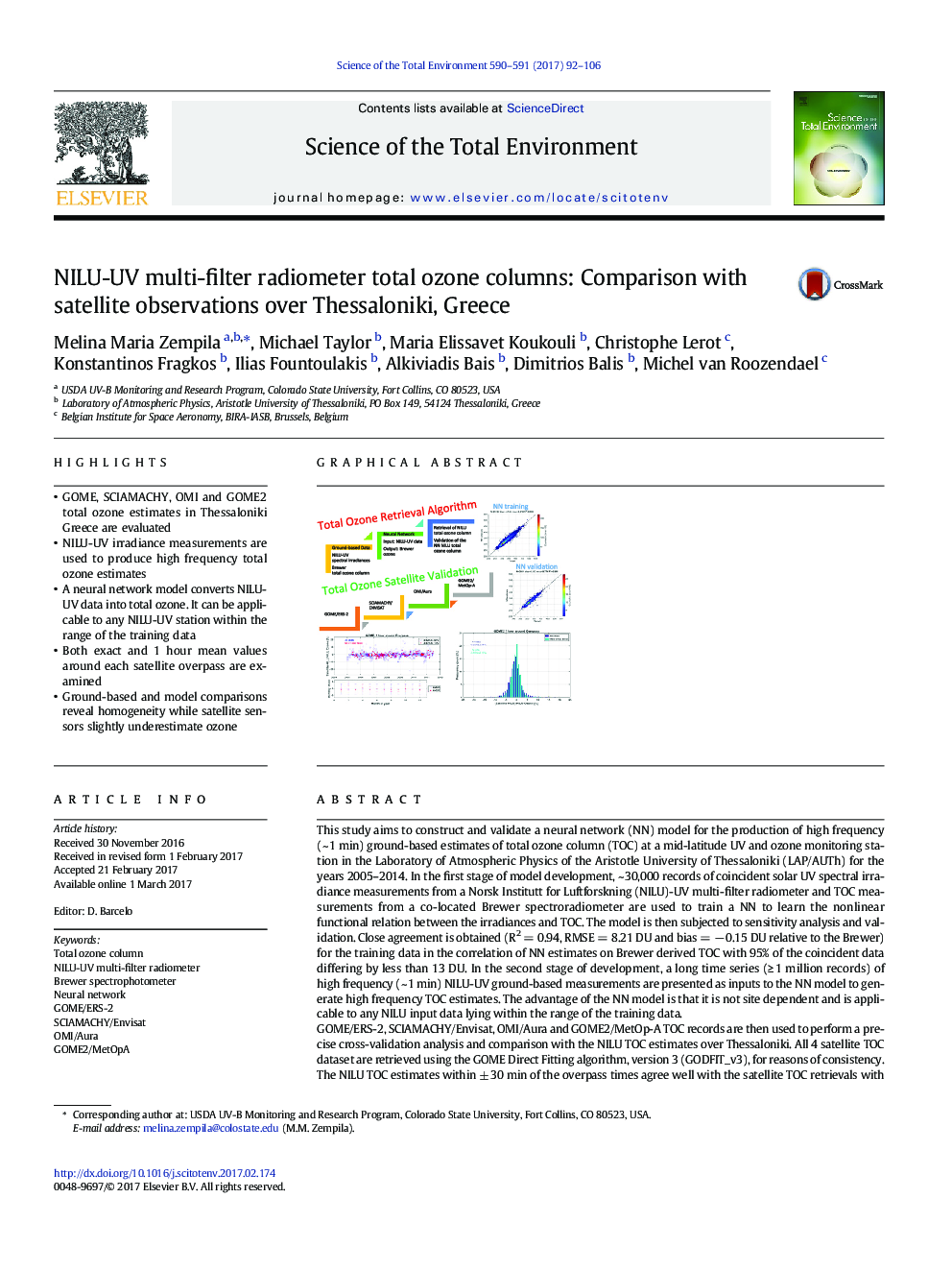| کد مقاله | کد نشریه | سال انتشار | مقاله انگلیسی | نسخه تمام متن |
|---|---|---|---|---|
| 5751024 | 1619704 | 2017 | 15 صفحه PDF | دانلود رایگان |

- GOME, SCIAMACHY, OMI and GOME2 total ozone estimates in Thessaloniki Greece are evaluated
- NILU-UV irradiance measurements are used to produce high frequency total ozone estimates
- A neural network model converts NILU-UV data into total ozone. It can be applicable to any NILU-UV station within the range of the training data
- Both exact and 1 hour mean values around each satellite overpass are examined
- Ground-based and model comparisons reveal homogeneity while satellite sensors slightly underestimate ozone
This study aims to construct and validate a neural network (NN) model for the production of high frequency (~ 1 min) ground-based estimates of total ozone column (TOC) at a mid-latitude UV and ozone monitoring station in the Laboratory of Atmospheric Physics of the Aristotle University of Thessaloniki (LAP/AUTh) for the years 2005-2014. In the first stage of model development, ~ 30,000 records of coincident solar UV spectral irradiance measurements from a Norsk Institutt for Luftforskning (NILU)-UV multi-filter radiometer and TOC measurements from a co-located Brewer spectroradiometer are used to train a NN to learn the nonlinear functional relation between the irradiances and TOC. The model is then subjected to sensitivity analysis and validation. Close agreement is obtained (R2 = 0.94, RMSE = 8.21 DU and bias = â 0.15 DU relative to the Brewer) for the training data in the correlation of NN estimates on Brewer derived TOC with 95% of the coincident data differing by less than 13 DU. In the second stage of development, a long time series (â¥Â 1 million records) of high frequency (~ 1 min) NILU-UV ground-based measurements are presented as inputs to the NN model to generate high frequency TOC estimates. The advantage of the NN model is that it is not site dependent and is applicable to any NILU input data lying within the range of the training data.GOME/ERS-2, SCIAMACHY/Envisat, OMI/Aura and GOME2/MetOp-A TOC records are then used to perform a precise cross-validation analysis and comparison with the NILU TOC estimates over Thessaloniki. All 4 satellite TOC dataset are retrieved using the GOME Direct Fitting algorithm, version 3 (GODFIT_v3), for reasons of consistency. The NILU TOC estimates within ± 30 min of the overpass times agree well with the satellite TOC retrievals with coefficient of determination in the range 0.88 â¤Â R2 â¤Â 0.90 for all sky conditions and 0.95 â¤Â R2 â¤Â 0.96 for clear sky conditions. The mean fractional differences are found to be â 0.67% ± 2.15%, â 1.44% ± 2.25%, â 2.09% ± 2.06% and â 0.85% ± 2.19% for GOME, SCIAMACHY, OMI and GOME2 respectively for the clear sky cases. The near constant standard deviation (~±2.2%) across the array of sensors testifies directly to the stability of both the GODFIT_v3 algorithm and the NN model for providing coherent and robust TOC records. Furthermore, the high Pearson product moment correlation coefficients (0.94 < R < 0.98) testify to the strength of the linear relationship between the satellite algorithm retrievals of TOC and ground-based estimates, while biases of less than 5 DU suggest that systematic errors are low. This novel methodology contributes to the ongoing assessment of the quality and consistency of ground and space-based measurements of total ozone columns.
223
Journal: Science of The Total Environment - Volumes 590â591, 15 July 2017, Pages 92-106